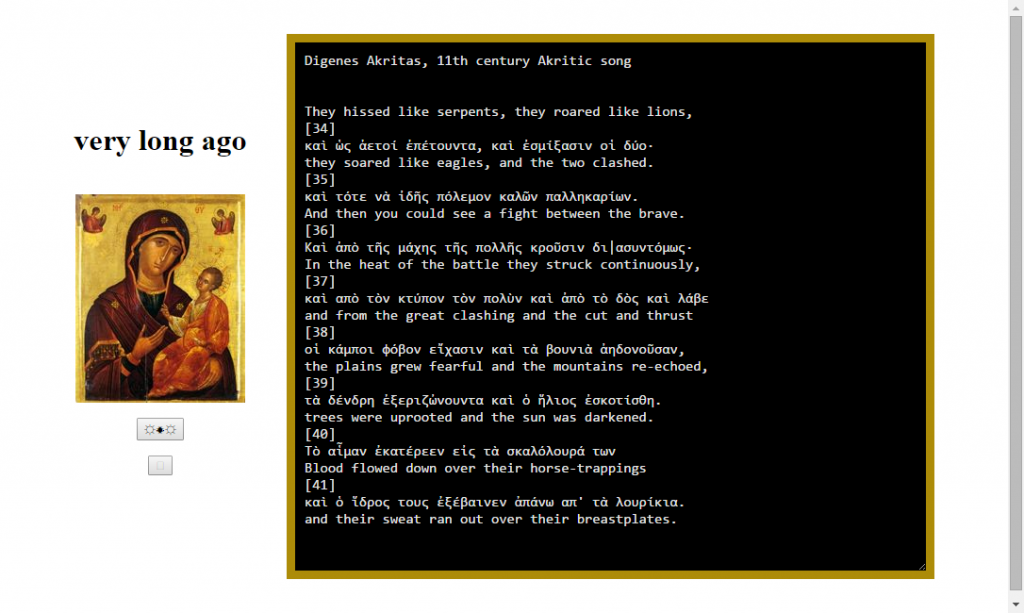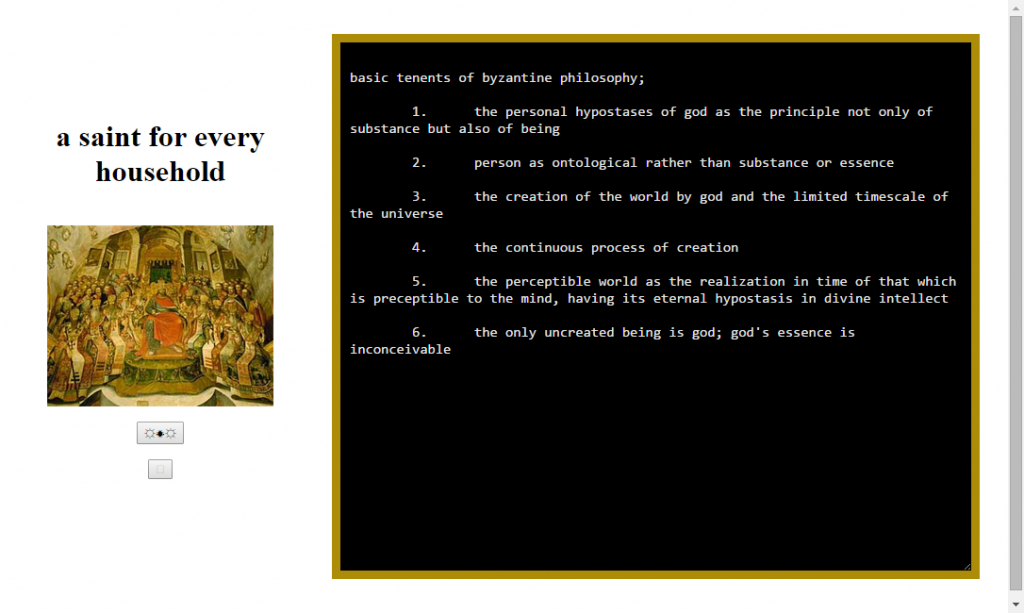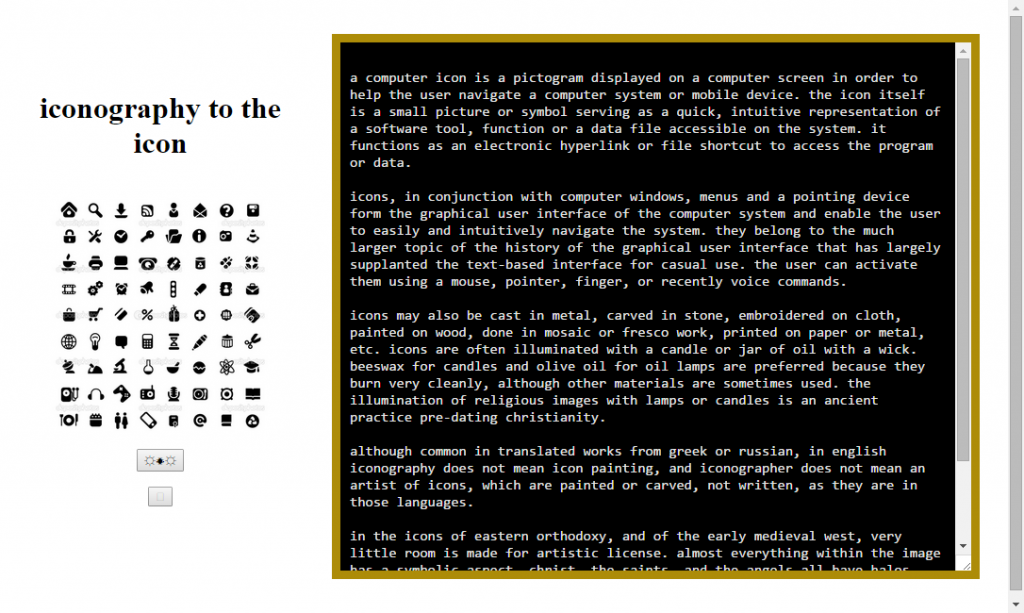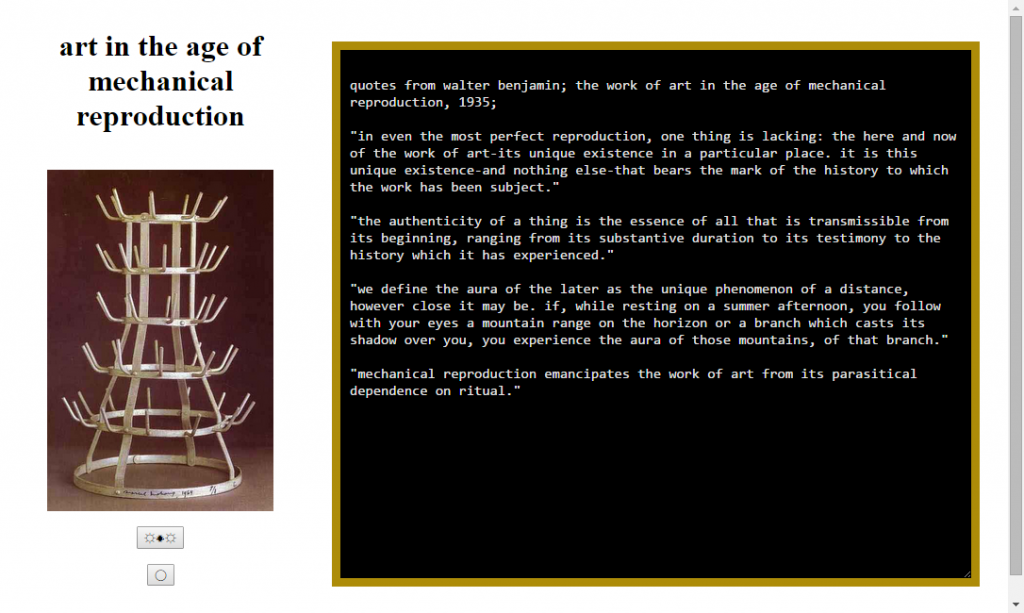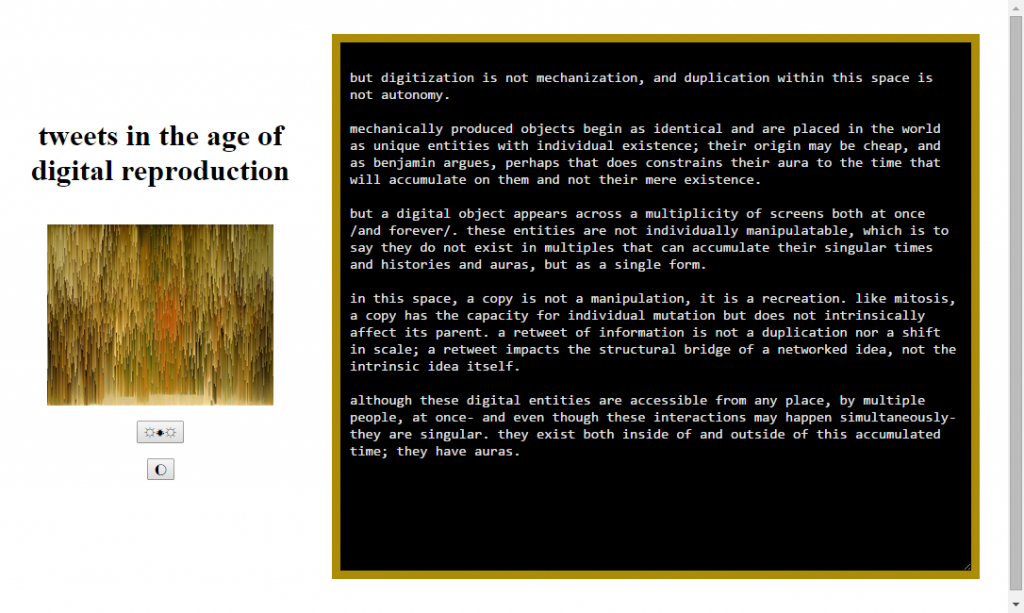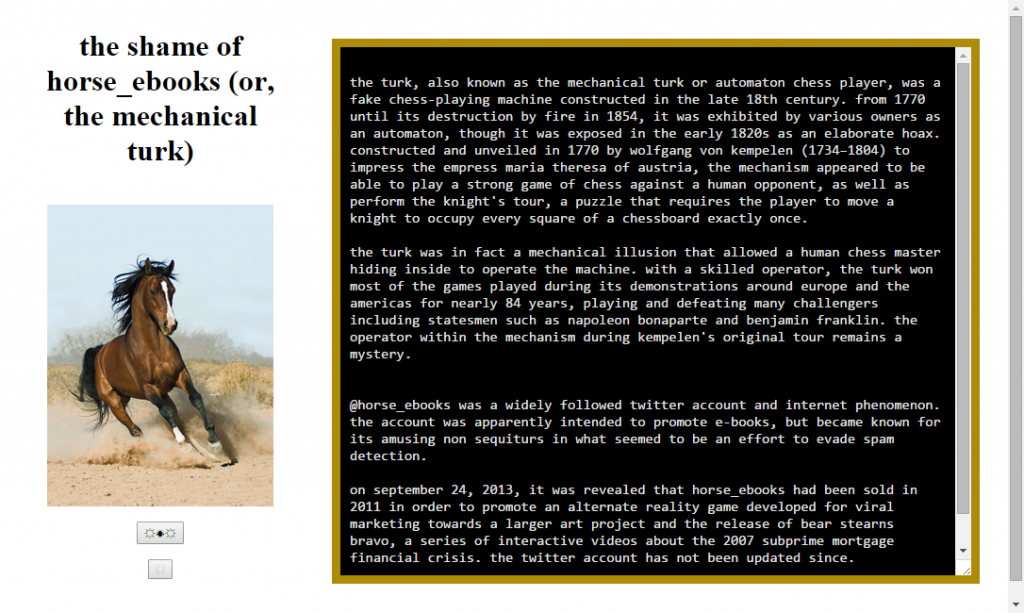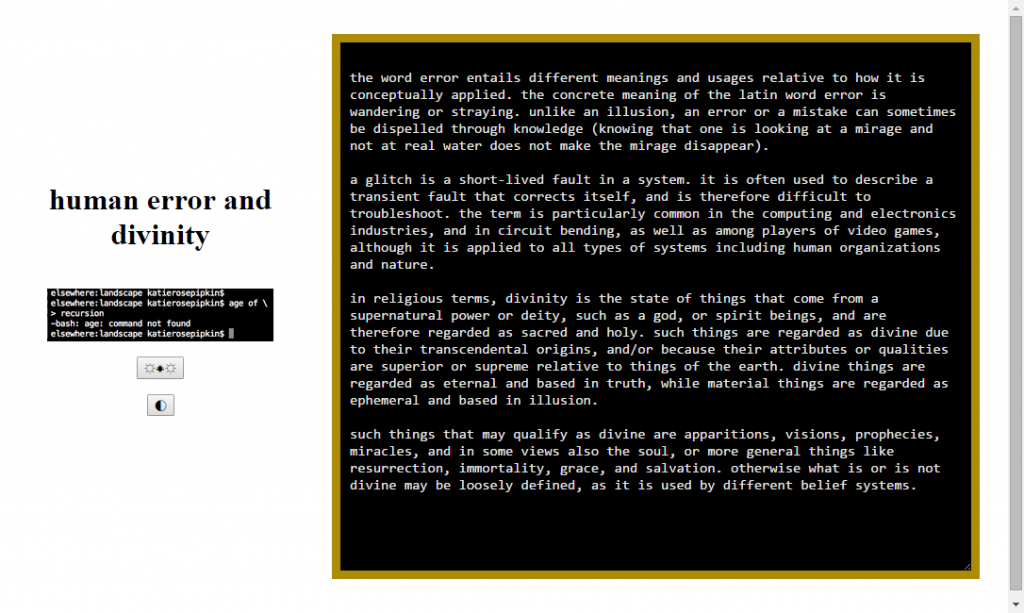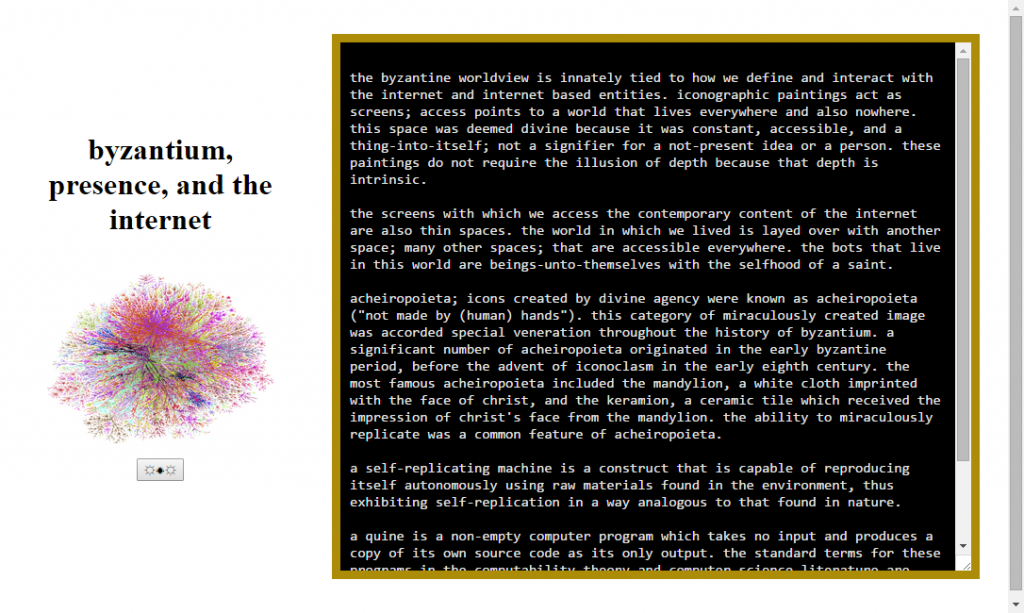[Everest’s slides have an interactive element. Each is linked from its caption.]
Okay, so I’m Everest. I want to thank my Markovian helper over some of my slides that I’ll be using through the course of this talk.
I know we’ve spent the day rooted in the short now, but I would ask you to humor me for a moment and cast your thoughts kind of backwards. I’d like to begin in the Byzantine Empire, the 11th century. Emperor Basil II has just died, and with his eclipsing reign begins the slow Imperial decline of the entire empire. The Great Schism, the theological split between the church in Rome, the church in Constantinople is looming on the horizon. Soon, the Crusades will shake the structure of regional power and daily life to the core. When speaking of this time, it’s important to hold in mind some fundamental qualities of the Byzantine worldview.
As a starting point, one can consider Patristic thought, which stems from 1st-century Rome, took lessons from the Old and later New Testaments, the Apostolic teachings, Greek philosophy, and Gnosticism. Byzantine philosophy always refers to what is beyond experience and nature, to the existence of God and to the real being. Byzantine worldview has shifted from the Platonic distinction between the intelligible and sensible world, and the difference between the here and the abstracted Platonic ideal that Plato spoke about in Greek philosophy. It instead talks about the distinction between the created and the uncreated beings. The uncreated is all that is divine. In general, the tension and desire to grasp the invisible, either by discursive reason or by faith characterizes Byzantine metaphysics. In short, it’s a space of intersectional worlds. Divine and mortal exist on one plane, touching, always.
After having looked at several icon paintings, one may notice that these objects only seem to exist on a flat plane. All depth is absent entirely. This is not an aesthetic choice. The third dimension of the icon painting is not space but spirit. The realm of the immortal intersects this one at every point in space and stretches to eternity. Such signifiers have no need for an artificial painted depth. They’re not windows into the diving, but literal divine objects that exist anywhere, but are viewable in this thin space.
Iconographic paintings are not signifiers but are physical structures that exist in both worlds. A picture of a saint is not a picture of a saint, it is the saint, physically in space with you.
So here we are a near perfect millennium later half-way across the world, considering the the act of painting God, and you’re probably wondering what on Earth this has to do with bots.
I’d like to touch base on some more recent history. Walter Benjamin’s iconic 1935 essay on the mechanized field of aesthetics. Benjamin claims that in the past, the role of artistic production has been to provide a magical foundation for the cult. He claims that then, value was located in a central position within ritual and religious tradition, a statue or an idol has a detached authority and power which is implicit only as rooted in time.
The mass reproduction of such an object was not just unlikely, it was unimaginable. To remove it from its history was to render it useless to itself, to remove the aura of object, that detached and transcendental beauty. This aura seems to rest on something autonomous and free from human intervention. The statue or the idol or the icon is not like any other object produced or used within a society. It appears free from ideological control or human interference, as though its power issues independently from within. He goes on to say “mechanical reproduction emancipates the work of art from its parasitical dependence on ritual.”
But digitization is not mechanization, and duplication within this space is not autonomy.
Mechanically produced objects begin as identical and are placed in the world as unique entities with individual existence. Their origin may be cheap and, as Benjamin argues, perhaps that does constrain their aura to the time that will accumulate on them and not their mere existence.
But a digital object appears across a multiplicity of screens both at once and forever. These entities are not individually manipulable, which is to say they do not exist in multiples that can accumulate their singular times and histories and auras, but as a single form. In this space, a copy is not a manipulation, it’s a recreation. Like mitosis, a copy has the capacity for individual mutation but does not intrinsically affect its parent. A retweet of information is not a duplication nor a shift in scale. A retweet impacts a structural bridge of a networked idea, not the intrinsic idea itself.
Although these digital entities are accessible from any place by multiple people at once, and even though these interactions may happen simultaneously, they’re singular. They exist both inside, of and outside of, this accumulated time; they have auras.
And what would this summit be if someone didn’t address the traitor?
I have two histories for you. You probably you know at least one of them, and the other is very topical.
First, the Mechanical Turk was a supposed automaton constructed in the late 18th century. The Turk was carved of wood, dressed in mystic robes and seated at a low table. He was capable of playing and winning at chess, as well as completing the puzzle game “the knight’s tour,” in which a knight occupies every square of a chess board exactly once, visiting all 64 squares. The table and Turk contained many doors, in which an audience may see that the complicated clockwork that drove the automaton was real. In the late 1820s, the Turk was exposed as a hoax. Inside the table was a tiny hidden box in which a diminutive chess master may hide and control the man above. Destroyed by fire in 1854, the Mechanical Turk has re-entered contemporary lexicon with the launching of Amazon’s website of the same name.
@horse_ebooks was an alleged spam bot originally written to sell ebooks that gained mass popularity for its poetic and strangely funny tweets. On September 24, 2013, it was announced that @horse_ebooks had become part of a multi-year performance art piece staged by Buzzfeed employee Jacob Bakkila. Bakkila had approached the original bot creator, supposedly Alexei Kuznetsov, in 2011 with the intent of buying the account. Kouznetzov agreed, and since 2011 @horse_ebooks has been operated by Bakkila. Before the revelation in September, it had more than 200,000 followers. @horse_ebooks has re-entered the contemporary lexicon in the form of the “_ebooks” bot.
I’m not sure why these incursions feel so traitorous to me. Maybe it’s because they seem just possible, just on this side of miraculous. To skirt that edge of possibility and trust is somewhat mean, but it also says something about where we are as a culture, happier to celebrate and lift up the things we can almost understand than to dissect them into disappointment.
I wanted to talk about mystery for a moment. I’m not very good at programming. I went to art school. Maybe it’s obvious. When pulling things together, I’m generally pretty surprised. I’m not often aware of what exactly I’m making until it works, and even then sometimes how it works is still beyond me. Maybe y’all are better at this than me, and of course anything can be designed to avoid all error, but as complications arise the capacity for 100% expected output grows pretty slim.
There is a strange beauty in failure, however. The sudden baring of internal process or broken function shows us something deeper about the pattern behind the designed process. In some ways it feels more true. Pulling undefineds and nulls and errors and grammatical problems, and corpus unreliability, and the fact that these things exist in a shifting landscape that is kind of unknowable… It’s watching a non-human simultaneously fail on a human level and continue to operate perfectly on its own level. It can be really special, maybe, somewhere, a little bit divine.
So I suppose what I’ve been skirting around over the course of this discussion is that I feel that the Byzantine worldview is innately tied to how we define and interact with the Internet and Internet-based entities. Iconographic paintings act as screens, access points to a world that lives everywhere and also nowhere. This space was deemed divine because it was constant, accessible, and a thing into itself in Byzantium, not a signifier for a not-present idea or a person. Not pointing to a Platonic form. These paintings did not require the illusion of depth because that depth is intrinsic.
The screens with which we access the contemporary content of the Internet are also thin spaces. The world in which we lived is laid over with another space, many other spaces, that are accessible everywhere. The bots that live in this world are beings unto themselves with the selfhood of a saint.
Before I go, I wanted to touch very very briefly about an early Byzantine concept that’s always been dear to me of acheiropoieta, icons created by non-human agency. They’re afforded this particular veneration within the church. They are defined almost exclusively by their ability to miraculously replicate themselves. Just a thought.
Thanks.
Further Reference
Interactive slides for this talk are posted online.
Darius Kazemi’s home page for Bot Summit 2014, with YouTube links to individual sessions, and a log of the IRC channel.
In March 2016, Everest published and expanded version of this presentation, “Selfhood, the icon, and byzantine presence on the Internet”

